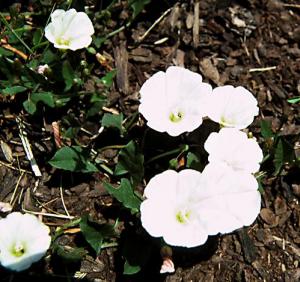CONTENTS
Registered Herbicides
[Return to weed
Identification]
[Return to Weed
Management]
[Home] |
|

General Description:
- Seedling: Cotyledons are spatulate in shape,
and are broad and indented at the tip. True leaves are alternate and spade or heart
shaped.
- Juvenile: Leaves are alternate, heart shaped,
and have blunt tips.
- Mature: The mature plants look like the
juveniles, but have flowers, and have a prostrate growth form.
- Flowers: Flowers are pink or white and funnel
shaped. There are two small bracts about one inch below the flowers.
- Biology: Field bind weed is a perennial weed,
and spreads both by seed and creeping roots.
Life cycle: perennial
Impact on Yield:
- Field bindweed is usually found as patch infestations
in mint stands and growers often avoid harvesting mint from pattches heavily infested with
field bindweed.
- Field bindweed has been shown to reduce peppermint oil
yield by as much as 35.4 lbs per acre (Ian Heap).
Herbicide Control Notes:
- Many growers find crop injury with Vine-Der
unacceptable. Lower rates may reduce crop injury; however, weed control might be
compromised by rates lower than those labeled.
|